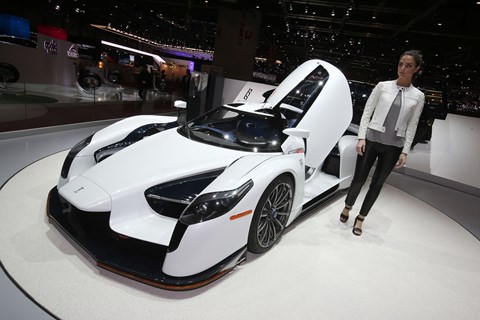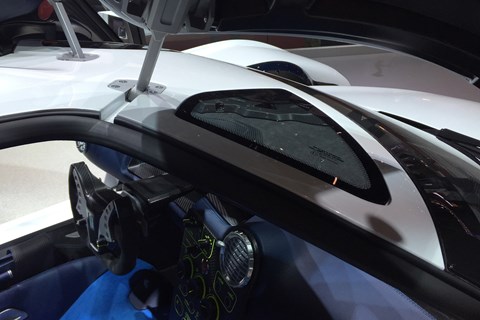► First official road car by SCG
► Evolved from 003C racing car
► Could lap Nordschleife in 6m30s
‘I’ve been coming to the Geneva motor show in a professional capacity since 1989,’ says the Glickenhaus SCG 003’s chief engineer (and former special projects boss at Pininfarina) Paulo Garella, ‘and I’ve never known so many people within the industry be so complimentary about a car. We are getting a lot of positive feedback; it’s very nice.’
Something tells me those compliments are sincere as he talks us around this intricate car in intricate detail, because the Scuderia Cameron Glickenhaus SCG 003S, to give it its full, unwieldy title, is a very special car indeed.
The ‘S’ suffix stands for Stradale, or road-going in Italian, because it’s a road-going version of the endurance racing car specifically designed for the Nurburgring 24 Hours. It’s been carefully reconfigured to be as friendly to drive on the road as a bespoke racing car is able to be, and its creators believe it will become the fastest road-legal car ever to lap the Nordschleife.

Back up a moment, please. Who are Scuderia Cameron Glickenhouse?
Jim Glickenhaus – tall, garrulous, likeably enthusiastic – is a New York-based former film director with a passion for sports cars and endurance racing, and one helluva car collection, including, for example, an ex-John Surtees Ferrari P3/4 and an ex-Bruce McLaren Ford MkIV Le Mans car – which he occasionally drives on the road. He’s also previously converted a Lola T70 Can Am car for road use, so if anyone understands the concept of racing cars for the road, he does.
He commissioned the 2006 Ferrari P4/5 one-off by Pininfarina, which wrapped the running gear from a Ferrari Enzo in bodywork inspired by his P3/4.
Scuderia Cameron Glickenhaus (named after Jim Glickenhaus’s wife Cameron) became a marque in its own right with the creation of competition versions of the P4/5 to race at the Nurburgring 24 Hours, engineered by Garella. Glickenhaus and Garella then decided to create a bespoke racing car of their own design – the SCG 003C, a GT3-style sports car with LMP levels of downforce – to race in the VLN series on the Nordschleife, winning its class in the Nurburgring 24 Hours. It’s called the 003 because it’s the third one-off design from the SCG stable, with the ‘C’ standing for Competizione.
And now this is the road version.

SCG 003S: technical highlights
This is a racing car that has been developed into a road car, not the other way round – think of it as the opposite to the McLaren F1. And yet in many ways it shares a similar ethos; Glickenhaus says the aim of SCG was always to design race cars that can also make exciting road cars, like the most celebrated sports racing cars of the ’60s.
Although SCG as a company is headquartered in New York, the car is constructed in Turin by Paolo Garella’s Manifattura Automobili Torino (MAT) outfit. Currently around 40 people are involved working on the SCG 003S.
- Engine – a heavily reworked evolution of the 4.4-litre twin-turbo V8 found in the BMW M6, using SCG’s own electronics. Unrestrained by racing regs, the 003 Stradale’s V8 is more powerful than the racing version’s V6, climbing from around 550 to 800 horsepower, and torque from 443lb ft to 627lb ft. ‘We could have 1000 horsepower, but you can’t use all that power effectively. It’s not about numbers for the sake of numbers,’ Glickenhaus says.
- Gearbox – Longitudinal seven-speed sequential paddleshift, with racing clutch modified to be smoother and more easy to use on the road.
- Chassis – carbonfibre monocoque with modular subframes, easily repaired and very safe. The bodywork is carbon, too.
SCG says the 003S can corner at over 2g on its road-legal Dunlops, developed specifically for the car. It generates huge downforce for a road car (or a racing car, for that matter): more than 700kg at 155mph.
‘In racing you have a number of constraints – [with a road car] you are much more free,’ Garella explains. ‘We have an extractor on the floor, the exhausts exit and accelerate the airflow to the wing.
‘Our rear structure is so narrow, we have two aerodynamic channels at the rear, things that frankly nobody else has at this level.
‘I wanted it to be very low – our objective was something like LMP2 or LMP1 – and you see there is no other car of this kind that has this kind of floor. All the engineers and mechanics were mad at me…’

How usable will the SCG 003S be on the road?
SCG exhibited two cars at Geneva – the white car pictured in the gallery, which is the first prototype for the 003S, and the blue car above, with an eye-catching translucent paint finish showing off the weave in its carbon bodywork beneath. That’s Jim Glickenhaus’s own road car, dubbed the 003CS (Competizione Stradale) and a kind of halfway-house between the racer and the new Stradale road car.
‘This car was originally our main race car,’ he explains. ‘It’s covered 15,000 race miles – it’s won its class at the Nurburgring 24 Hours, it’s been crashed, it’s been on fire, it’s been thoroughly tested. When it was time to retire it from racing we thought, “why not put it on the road?” It has a New York state VIN number and licence plate. I love to drive it, but compared with the SCG003S, it’s more extreme. The Stradale will be more compliant, easier to see out of, more comfortable, better ventilated.’
To that end, the S features a host of neat details; extra portholes in the roof above the windscreen (below), the better to see traffic lights at junctions, for instance, neatly designed removable luggage bags to slot between the seats and sill, and a smartphone link for the digital instrument panel.
Jim Glickenhaus: ‘Why have the weight of a sat-nav system? All the OEM systems, they suck – my wife has a Bentley, the nav is unusable – but the one on your iPhone really works well. So this clones to the screen, you know how to use it, you have your music, we have speakers. It’s much more lightweight, and you’re good to go.’

Who is the SCG 003S aimed at?
Ideal customers for the SCG 003S will be those who will use the car properly, rather than locking it into an air-conditioned collection as an appreciating asset.
Despite its extreme racing origins, Jim Glickenhaus says the 003S will be as usable a road car as possible: ‘We want our customers to use the cars, and to give us feedback to continually improve them. I want it to be usable on the road – when you’re driving a GT40, for example, you have one eye checking the temperature gauges all the time.’ He says that although the SCG 003S is a racing car that has been developed into a road car, it is a road car nonetheless, albeit an extreme one.
‘For me it has been a fantastic project,’ says Garella, ‘because I had the freedom to do things I [have been] thinking since years [ago], and it gave me the opportunity to put all this learning in one car, which I design, I thought, I did – although with very talented young engineers working with me.’
Walk around the SCG 003S and the details are exquisite: the air-con vents designed to be identical to the ’60s Renault mouldings Ferrari used in the P3 and P4; the wooden scuff guards on the front splitter made from the same material as the ‘planks’ beneath F1 cars (‘so if you’re going to prang the nose, you’re only screwing a piece of wood,’ Glickenhaus says); and the bodywork surfaces shaped ruthlessly by the quest for downforce.
It’s not a beautiful car, but it’s deeply attractive in a functional kind of way. SCG plans to build around four 003S cars a year, at a cost of around $1.8m each, with the first customer delivery in autumn 2017. One of them, or a Bugatti Chiron? If I had a spare million burning a hole in my bank account, I’d give SCG a call.
SCG 003S aims to break Nurburgring lap record